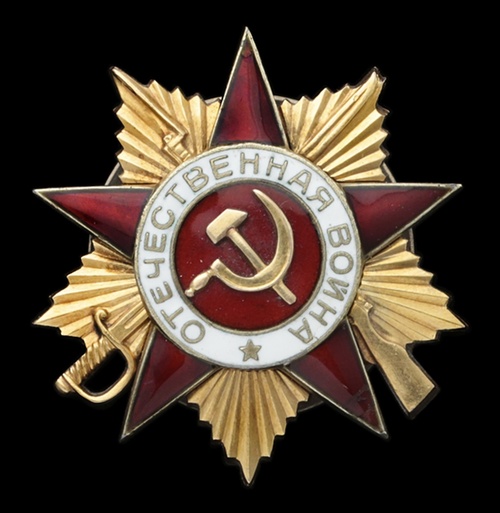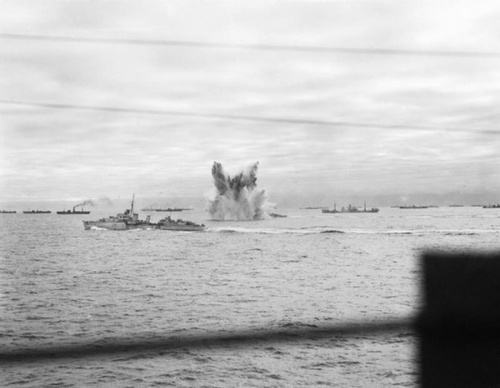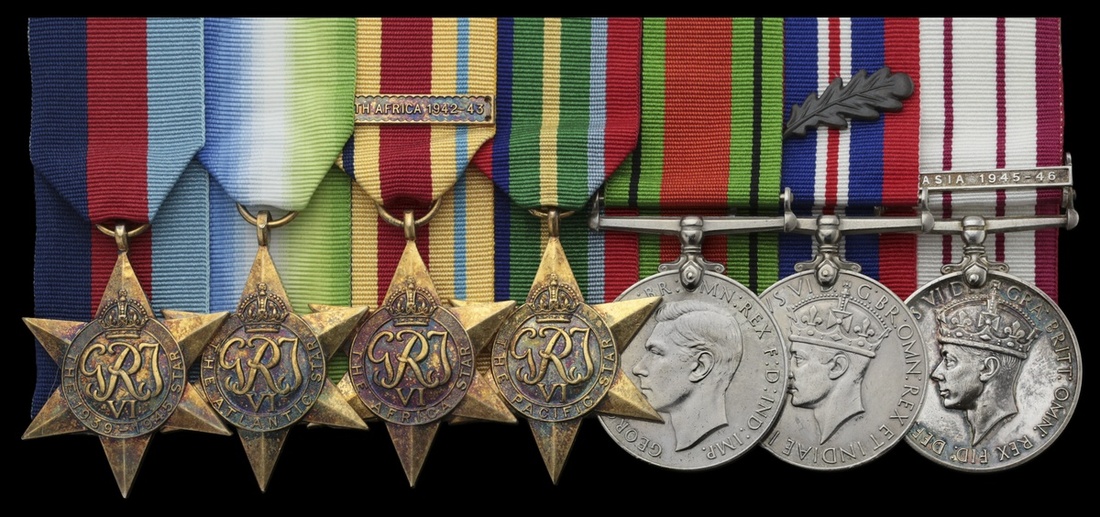Auction: 22003 - Orders, Decorations and Medals
Lot: 402
'Suddenly there was one of the most horrifying sights of the war. Along the whole horizon were aircraft flying just above the waves wing tip to wing tip and below radar cover. This was the German 'Golden Comb' attack in which all the planes released two torpedoes each at the same time. Records show there were forty-two Heinkel torpedo bombers and a number of Junkers 88s.
Everything was happening - as soon as they were seen the commodore of the convoy [PQ 18] ordered an emergency turn away in order to comb the tracks of the torpedoes but unfortunately the two starboard columns did not comply. Like all the others Eskimo put the helm hard over and increased speed, which made the ship list and heel over. These frantic manoeuvres made it impossible for any accurate gunfire. However, every ship blasted off with everything and the air was thick with bullets.
The Eskimo was in the starboard column of the screen and this menacing swarm passed a few feet overhead and as the aircraft were travelling at about 250 miles an hour they were gone before you could say 'Jack Robinson'. We were not their prime target and shortly after passing us they released no less than 110 torpedoes.
In no time eight ships were hit, some sank at once and in one case, there was a gigantic explosion sending a column of black smoke vertically upwards and the ship vanished completely.
The barrage that was fired at the attackers was terrific, but according to German records only five planes were shot down though many more must have been damaged … '
High drama on the Arctic run on 13 September 1942, as described by John Manners, the First Lieutenant of H.M.S. Eskimo.
The important - and excessively rare - Second World War Mediterranean and Arctic convoy group of eight awarded to Commander C. A. Langton, Royal Navy, one of a handful of British officers to be awarded the Soviet Order of Patriotic War 1st Class
The decoration stemmed from his gallant service as First Lieutenant of the flotilla leader H.M.S. Malcolm in the heavily contested QP-18 operation in September 1942 when, in a single day, the Luftwaffe mounted eight serious assaults on the convoy: the sky was so thick with enemy aircraft that one witness likened them to 'a cloud of phantom locusts'
But Langton was no stranger to wartime encounters of the closest kind, for he had already been mentioned in despatches for the destroyer Firedrake's part in the destruction of the U-39 in September 1939, the first U-boat 'kill' of the war
1939-45 Star; Atlantic Star; Africa Star, clasp, North Africa 1942-43; Pacific Star; Defence and War Medals, M.I.D. oak leaf; Naval General Service 1915-62, one clasp, S.E. Asia 1945-46 (Lt. Cdr. C. A. Langton, R.N.); U.S.S.R., Order of Patriotic War, 1st Class, minor enamel damage to arm tips of the last, otherwise good very fine (8)
U.S.S.R. Order of Patriotic War, 1st Class London Gazette 11 April 1949.
Approximately 25 such awards were made to members of the British and Commonwealth Forces in the Second World War and just five of these to Royal Naval personnel.
Charles Arthur Langton was born in Chippenham, Wiltshire on 30 July 1914 and entered the Royal Navy as a Midshipman in May 1932.
H.M.S. Firedrake - first U-boat 'kill' of the war - 'mention'
By the outbreak of hostilities in September 1939, he was serving as a Lieutenant in the destroyer H.M.S. Firedrake, in which capacity he quickly saw action under her popular skipper, Commander Stephen 'Nudger' Norris, D.S.O., D.S.C., R.N.
On 14 September 1939, Firedrake - and her consorts Faulknor and Foxhound - destroyed the U-39 off the north-west coast of Ireland, thereby claiming the first such 'kill' of the war.
U-39 had just carried out an unsuccessful attack on the carrier Ark Royal and, on receiving a report of the attack, Firedrake and her consorts set-off in pursuit. Hitler's U-Boat War - The Hunters 1939-42, by Clay Blair, takes up the story:
'Sonar conditions were good; the operators were among the best in the fleet. Within eighteen minutes, both Foxhound and Faulkner had sonar contact. Foxhound attacked immediately, dropping two depth charges, one set to 250 feet, one for 300 feet. Faulkner followed with five more depth charges set for 100 feet and 150 feet. In the noise of exploding depth charges, both of the destroyers lost contact, but Firedrake did not, and she moved in to drop five more charges and between 250 feet and 500 feet.
These twelve depth charges exploded close and rocked U-39 violently. The first batch caused arcing flames in the battery and knocked out all lighting. Glattes took U-39 deep (to about 230 feet) but the second salvo caught her and cracked sea valves and flanges. Salt water flooded into the battery, generating deadly chlorine gas. Then the electric motors shut down and U-39, unable to manoeuvre submerged, went out of control.
No one on U-39 had ever experienced noise and terror on this scale. After twenty minutes of it, a shaken Glattes concluded the boat was fatally damaged, and he commanded the crew to prepare to abandon ship and blew all main ballast tanks.
At 1546 - thirty-nine minutes after firing the torpedoes - U-39 broke surface, bow up, in broad daylight, surrounded by three destroyers. All three vessels opened fire with guns, but when it was seen that U-39's crew was jumping overboard, the destroyers checked fire. Glattes's men had set a scuttling charge and opened the forward torpedo-room hatch. The charge exploded as designed and U-39, fatally holed, went down bow first - the first U-boat to be lost in the war. The three destroyers launched boats and fished forty-three bearded, shocked U-39 survivors from the water. There were no casualties.'
For his part in this landmark action, Langton was mentioned in despatches (London Gazette 1 January 1940, refers).
"Firedrake" - Norway and beyond
Next deployed to Norwegian waters, Firedrake assisted at the evacuation of troops from Bode, Harstad, Borkenes and Narvik in May-June 1940, and was twice slightly damaged by enemy aircraft; but for 'Nudger' Norris's habit of lying on his back on the bridge to see where the Stukas unloaded their bombs - and direct his ship accordingly - that damage may have been mortal.
In August 1940, Langton and his shipmates set sail for Gibraltar to join Force H and, on 18 October, Firedrake - with her consort Wrestler - claimed her second enemy submarine, the Italian Durbo. Better still, a boarding party was able to recover secret cipher and operational data, which information led to the destruction of the Italian submarine Lafole two days later.
The battle of Cape Spartivento aside, Langton and his shipmates also participated in some notable Mediterranean actions in 1941, among them Operation "Substance" in July, when Firedrake was damaged by a near miss and had to be towed back to Gibraltar.
"Malcolm": QP-18 - second 'mention' and a rare case of Soviet recognition
Having then participated in a number of convoys as part of Escort Group B7 in the Mid-Ocean Escort Force, Langton removed to the flotilla leader Malcolm as her First Lieutenant in August 1942.
He duly witnessed extensive action in Arctic convoy PQ-18 in September, in which Malcom acted as leader of the close escort.
Richard Woodman takes up the story in Arctic Convoys:
'A formidable array of aircraft prepared to attack PQ-18 from northern Norway. Forty-two Heinkel He. 111H-6 torpedo-bombers of KG26 were joined by thirty-five Junkers Ju. 88A-17s of KG26, the faster Ju. 88 modification capable of carrying torpedoes, which had been flown up from France. These aircraft were, of course, supported by the long-range Condors and Blohm and Voss flying boats though not by fighters, which did not possess the range to cover the bombers. They were, however, bolstered by the Ju. 88 bombers of KG30 and this combination allowed the Luftwaffe to employ a tactic known as the Golden Zange, or golden Comb, a conjoint low-level airborne torpedo attack which was supported by diversionary medium-level and dive-bombing. By this tactic it was hoped to fragment a convoy's defences and enable the torpedo-bombers, who at low altitude would duck under the surveillance radar, to press home a devastating and overwhelming onslaught.
Intelligence had revealed that an aircraft-carrier would accompany the convoy and Goering insisted that 'the attack against the aircraft-carrier must be so violent that this threat is removed.' Despite this, German aircraft tended always to seek out merchant ships, knowing that in doing so they were aiming for the most significant targets. A victory over PQ-18, the young pilots were told, would help their comrades in the Wehrmacht, easing the conquest of the Caucasus and the capture of Stalingrad by depriving the Red Army of its sinews.'
On 14 September 1942, the Luftwaffe delivered no less than eight major assaults against PQ-18, large forces of Ju. 88s, He. 111s and He. 115s unleashing a torrent of bombs and torpedoes, many of the latter finding their mark. In fact so thick was the sky with enemy aircraft that the Commodore likened them to 'a cloud of phantom locusts', while a young Sub. Lieutenant recalled seeing them 'rise up on the horizon, black and repulsive', where 'they extended far on either side of our view' - a scene which shortly became even more memorable with the advent of the intense A.A. fire put up by our ships. Of events on the 14th, Russell [of the Malcolm] later reported:
'Monday 14th opened inauspiciously with the torpedoing by a U-Boat of the Athel Templar close south of Spitzbergen at 0325. At 1235, whilst Malcolm was oiling, torpedo bombers attacked the port side of the convoy from ahead. Three or four were shot down and no damage resulted. At 1330 14 Ju., 88s started dive-bombing through the clouds and at 1400 another torpedo bomber attack developed from right ahead, most of the aircraft passing between Malcolm (centre of the ahead screen) and Achates (next ship to port). Three aircraft were shot down and two ships torpedoed, but one of these ships got going again and continued with the convoy. Intermittent dive-bombing by Ju. 88s continued until 1502 and it appeared as if Scylla, Avenger and the screen were the targets. Hope Island was sighted at 1800. Numerous H/F and M/F D/F bearings suggested that the U-Boat Pack would attack during the short period of darkness, but no attack developed ... '
Following an epic seven day running battle, in which Malcolm also carried out at least two depth-charge attacks, the convoy arrived in Archangel towards the end of the month.
The Germans managed to sink 13 of the convoy's merchantmen for a loss of four U-boats and 44 aircraft, namely 38 torpedo-bombers and six long range bombers and reconnaissance aircraft.
Langton was recommended for a decoration but instead received his second "mention" (London Gazette 8 December 1942, refers), in addition to the extremely rare accolade of the Soviet Order of Patriotic War, 1st Class (London Gazette 11 April 1949, refers). The recommendation cited his outstanding ability as Executive Officer, A./S. Controller and H.A. Control Officer.
Subsequent career
As part of the North African "Torch" operations in November 1942, Malcolm was charged with disembarking a party of U.S. Marines inside the harbour of Argel, along with her consort Broke. Illuminated by enemy searchlights on her approach, Malcolm was hit and disabled by fire from the Vichy battery of Les Arcades, suffering a loss of 10 killed and 27 wounded.
Langton departed Malcolm in August 1943 and, having been employed ashore in the interim, joined the destroyer Caesar in October 1944; it was in this capacity that he gained his Pacific Star and Naval General Service Medal for S.E. Asia 1945-46.
The Commander died at Alton, Hampshire on 11 February 1971.
Subject to 20% VAT on Buyer’s Premium. For more information please view Terms and Conditions for Buyers.
Sold for
£2,500
Starting price
£1600











